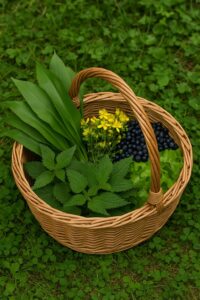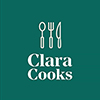Wandering The Wild – Foraging in Ireland

Wandering the Wild: Foraging in Ireland
by Clara Cooney
There’s something magical about walking through the Irish countryside and realising that the land itself is offering you food. I first discovered foraging, although I didn’t realise I was actually foraging in the fields beside my grandparents’ house as a child, when the hedgerows were heavy with blackberries. The juice stained my fingers as I picked handful after handful, and ate plenty as we filled up our buckets!
Ireland is made for foragers. The damp air, rolling fields, and rugged coastlines create a year-round pantry—if you know where to look. Here are some of the wild treasures you might stumble upon as the seasons shift.
Spring: The Green Awakening
As winter fades, the woods and riverbanks come alive. Wild garlic carpets shady paths with its starry white flowers and unmistakable scent—you can smell it before you see it. The leaves, when blended into pesto, bring a sharp, fresh bite that tastes like spring itself.
Nearby, young nettles poke through. Don’t let their sting fool you—once simmered in a pot, they transform into an earthy, iron-rich soup that Irish grandmothers have sworn by for generations.
Summer: Blossoms and Berries
Summer in Ireland means elderflowers. Walking past an elder tree in June, you’ll catch a honey-sweet perfume drifting on the breeze. Many foragers snip the blossoms to make cordial—a bottle of sunshine that lasts well into winter.
Up in the hills, bilberries (fraochán) ripen into tiny purple jewels. They’re smaller than supermarket blueberries, but their tartness makes them perfect for cooked desserts. If you’re lucky, you’ll return from your walk with blue-stained fingertips and a basket full of memories.
Autumn: A Hedgerow Harvest
Come August and September, hedgerows are overflowing with blackberries, although these days they start much earlier. There’s a tradition in some parts of Ireland that they shouldn’t be picked after Halloween—said to be the night when the púca, a mischievous spirit, spoils them. Superstition or not, the berries taste best in late summer and early autumn, baked into crumbles or simmered into jam or delicious compote
Woodlands hide their own autumn feast. Mushrooms like chanterelles appear after rain, golden against the damp moss. But here caution is vital—only forage mushrooms you can confidently identify.
Winter: Gifts of the Sea
When the trees are bare and the land seems quiet, the sea offers its bounty. On a low tide along the west coast, you’ll find ribbons of sea lettuce and fronds of dulse clinging to rocks. Irish people have dried and eaten these seaweeds for centuries, sometimes as snacks, sometimes as cures.
Another winter treasure is carrageen moss, a red seaweed that turns into a natural thickener when boiled. Long before fancy health trends, Irish households were using it to soothe colds and make puddings.
A Few Golden Rules
Foraging in Ireland is about more than food—it’s about respect. Take only what you need, leave plenty for wildlife, and always be certain of what you’re picking. If in doubt, don’t eat it. And remember, the joy isn’t only in the harvest but in the noticing: the shift of seasons, the quiet generosity of nature.
For me, foraging has become a way to slow down and see Ireland in a different light. A walk by the coast isn’t just scenery anymore—it’s an invitation. A hedgerow isn’t just a tangle of branches—it’s a feast waiting to be discovered.
If you ever find yourself wandering the Irish countryside, basket in hand, pause and look closely. The wild larder is always open—you just need to step inside.
If you’re new, consider joining a guided foraging walk. Across Ireland, experts lead tours along woodlands, bogs, and coasts, teaching safe identification and offering recipes for your finds. Books and local heritage groups are also great resources.
However, if you fancy trying this out yourself, then below is a Foraging Calendar I’ve put together to get you started. Look them up so you can get an idea of what to look out for each month.
Foraging Calendar – Edible Plants of Ireland
January – Nettles (young shoots), Cleavers (young shoots), Alexanders (shoots & stems), Sea beet, Chickweed
February – Wild garlic (leaves begin), Nettles (new shoots), Alexanders (flower buds), Cleavers (shoots), Dandelion leaves
March – Wild garlic (leaves & buds), Three-cornered leek, Nettles, Ground elder (shoots), Dandelion leaves & flowers, Chickweed, Gorse flowers
April – Wild garlic (flowers), Nettles, Ground elder, Sorrel, Gorse flowers, Garlic mustard, Cleavers, Dandelion (flowers & roots)
May – Elderflowers, Hawthorn leaves & blossoms, Wild garlic (last), Garlic mustard, Sorrel, Sea kale, Nettle tops
June – Wild strawberries, Meadowsweet (flowers), Elderflowers (late), Rose petals, Sea beet, Gooseberries, Marsh samphire
July – Bilberries (fraughans), Meadowsweet (flowers), Wild raspberries, Sea rocket, Marsh samphire, Yarrow, Nettle seeds
August – Blackberries, Bilberries, Elderberries, Crab apples, Rowan berries, Wild raspberries, Wild mint, Meadowsweet (last flowers)
September – Blackberries (peak), Elderberries, Hawthorn berries, Sloes, Rose hips, Hazelnuts, Crab apples, Rowan berries, Chickweed
October – Sweet chestnuts, Beech nuts, Hazelnuts, Sloes, Rose hips, Hawthorn berries, Late blackberries, Sea beet
November – Rose hips (frost-sweetened), Sloes, Chickweed, Cleavers (shoots), Sea beet, Dandelion roots
December – Alexanders (young shoots), Chickweed, Cleavers, Nettles (mild weather), Sea beet, Dandelion root
Go Forage and enjoy!

